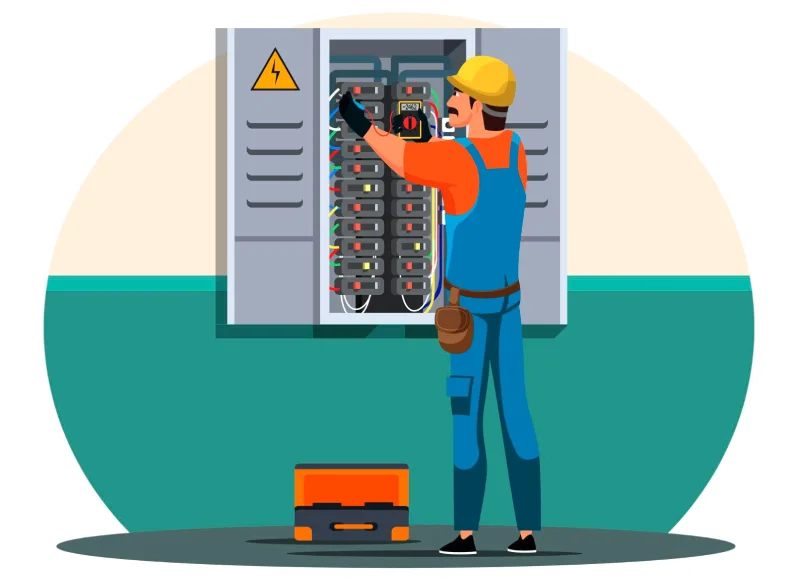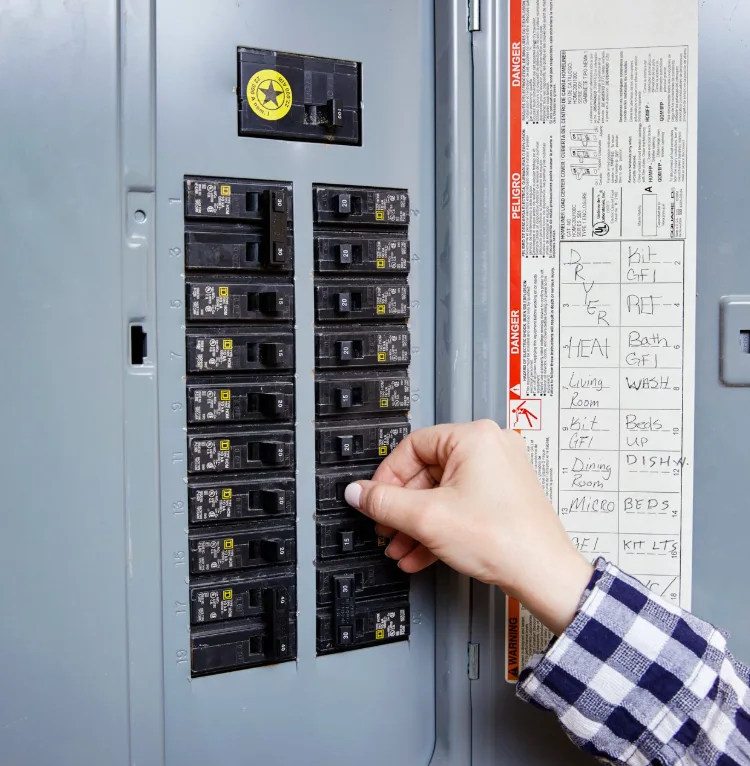Ο κύριος διακόπτης βρίσκεται συνήθως στην κορυφή του σπιτιού σας. ηλεκτρικός πίνακας (κουτί διακόπτη), το οποίο βρίσκεται συνήθως σε εξωτερικό τοίχο, στο υπόγειο, στο γκαράζ, στο βοηθητικό δωμάτιο ή κοντά στον μετρητή ηλεκτρικού ρεύματος. Η κατανόηση της θέσης του κύριου διακόπτη σας είναι ζωτικής σημασίας για τις διακοπές ρεύματος έκτακτης ανάγκης και την ηλεκτρική ασφάλεια.
⚠️ ΠΡΟΕΙΔΟΠΟΙΗΣΗ ΑΣΦΑΛΕΙΑΣΝα είστε πάντα εξαιρετικά προσεκτικοί κοντά στους ηλεκτρικούς πίνακες. Εάν δεν είστε σίγουροι για οποιαδήποτε ηλεκτρολογική εργασία, συμβουλευτείτε αμέσως έναν αδειούχο ηλεκτρολόγο.
Τι είναι ένας κύριος διακόπτης και γιατί έχει σημασία η τοποθεσία;
Ορισμός κύριου διακόπτη
A κύριος διακόπτης είναι το κύριο διακόπτης κυκλώματος που ελέγχει όλη την ηλεκτρική ενέργεια που εισέρχεται στο σπίτι σας από την εταιρεία κοινής ωφέλειας. Λειτουργεί ως ο κύριος διακόπτης διακοπής για ολόκληρο το ηλεκτρικό σας σύστημα, με τυπική ονομαστική ισχύ μεταξύ 100-200 αμπέρ για κατοικίες.
Γιατί η γνώση της τοποθεσίας είναι κρίσιμη
- Διακοπές έκτακτης ανάγκης κατά τη διάρκεια ηλεκτρικών πυρκαγιών ή πλημμυρών
- Προετοιμασία ηλεκτρολογικών εργασιών από εργολάβους
- Διαχείριση ενέργειας κατά τη διάρκεια καταιγίδων ή διακοπών ρεύματος
- Συμμόρφωση με την ασφάλεια με τους τοπικούς ηλεκτρικούς κώδικες
- Απαιτήσεις επιθεώρησης κατοικίας για συναλλαγές ακινήτων
Θέση κύριου διακόπτη ανά τύπο κατοικίας: Πίνακας γρήγορης αναφοράς
| Τύπος σπιτιού | Η πιο συνηθισμένη τοποθεσία | Δευτερεύουσες τοποθεσίες | Σημειώσεις πρόσβασης |
|---|---|---|---|
| Μονοκατοικία | Γκαράζ ή εξωτερικός τοίχος | Υπόγειο, βοηθητικό δωμάτιο | Συνήθως στο ύψος των ματιών |
| Μεζονέτα/Διαμέρισμα | Εσωτερική βοηθητική ντουλάπα | Γκαράζ, υπόγειο | Μπορεί να είναι κοινόχρηστο πάνελ |
| Διαμέρισμα | Ντουλάπα κουζίνας/διαδρόμου | Ντουλάπα υπνοδωματίου | Συχνά επισημαίνεται με αριθμό μονάδας |
| Κινητό Σπίτι | Εξωτερικό πάνελ κοντά στο μετρητή | Χώρος κοινής ωφέλειας κάτω από το σπίτι | Κουτί με προστασία από τις καιρικές συνθήκες |
| Παλαιότερα Σπίτια (Πριν από το 1960) | Υπόγειο κοντά στο μετρητή | Κουτί ασφαλειών αντί για διακόπτες | Μπορεί να χρειαστεί ηλεκτρική αναβάθμιση |
Οδηγός βήμα προς βήμα για τον εντοπισμό του κύριου διακόπτη σας
Βήμα 1: Ξεκινήστε με τον μετρητή ηλεκτρικού ρεύματος
- Βγες έξω και εντοπίστε τον ηλεκτρικό σας μετρητή (συνήθως τοποθετημένο σε εξωτερικό τοίχο)
- Κοιτάξτε κοντά για ένα γκρι ή καφέ μεταλλικό κουτί (ηλεκτρικός πίνακας)
- Ελέγξτε σε απόσταση 10 ποδιών του μετρητή – ο κώδικας απαιτεί κοντινή απόσταση
Βήμα 2: Ελέγξτε τις κοινές εσωτερικές τοποθεσίες
- ΥπόγειοΚοντά στο σημείο όπου εισέρχονται τα καλώδια ρεύματος στο σπίτι
- Γκαράζ: Κατά μήκος των τοίχων, συνήθως απέναντι από την είσοδο του σπιτιού
- Βοηθητικό δωμάτιοΣυχνά συνδυάζεται με εξοπλισμό θερμοσίφωνα/HVAC
- Χώρος κουζίναςΣε παλαιότερα σπίτια, μερικές φορές σε ντουλάπες κουζίνας
- Ντουλάπες διαδρόμουΕιδικά σε διαμερίσματα και μεζονέτες
Βήμα 3: Προσδιορίστε τον κύριο διακόπτη
- Ανοίξτε το κάλυμμα του πάνελ (αν είναι ασφαλές να το κάνετε)
- Αναζητήστε τον μεγαλύτερο διαρρήκτη – συνήθως στην κορυφή
- Ελέγξτε την ετικέτα – θα πρέπει να αναγράφει «ΚΥΡΙΟ» ή να δείχνει την υψηλότερη ένταση ρεύματος (100A, 150A, 200A)
- Επαληθεύστε ότι ελέγχει πολλαπλά κυκλώματα – όχι μόνο μία πρίζα ή συσκευή
Συμβουλή ειδικούΟ κύριος διακόπτης έχει συνήθως διπλάσιο πλάτος από τους τυπικούς διακόπτες κυκλώματος και έχει δύο διακόπτες που κινούνται μαζί.
Κύριοι τύποι και διαμορφώσεις διακοπτών
Τυπικός πίνακας κύριου διακόπτη
- Τοποθεσία: Πάνω μέρος του ηλεκτρικού πίνακα
- ΕμφάνισηΔιακόπτης διπλού πλάτους
- ΛειτουργίαΕλέγχει όλη την ισχύ στους υποδιακόπτες από κάτω
- ΑξιολόγησηΣυνήθως ταιριάζει με την χωρητικότητα του πίνακα (100A-200A)
Κύριο πάνελ ωτίδων (χωρίς κύριο διακόπτη)
- Τοποθεσία: Έλεγχος ισχύος μέσω εξωτερικής αποσύνδεσης
- ΕμφάνισηΔεν υπάρχει κύριος διακόπτης στον πίνακα
- Λειτουργία: Άμεση σύνδεση από τον μετρητή στον πίνακα
- Σημείωση ασφαλείας: Πρέπει να εντοπίσετε την εξωτερική αποσύνδεση για την απενεργοποίηση
Πίνακας Split-Bus (Καταρριωμένος)
- ΤοποθεσίαΠολλαπλοί κύριοι διακόπτες σε παλαιότερα πάνελ
- Εμφάνιση: 6 ή λιγότερα μεγάλα breaker στην κορυφή
- ΛειτουργίαΔεν υπάρχει μία μόνο κύρια διακοπή
- Σύσταση: Εξετάστε το ενδεχόμενο αναβάθμισης του ηλεκτρικού πίνακα
Απαιτήσεις ασφαλείας και συμμόρφωση με τον κώδικα
Εθνικός Ηλεκτρικός Κώδικας (NEC) Απαιτήσεις
- ΎψοςΚέντρο πάνελ μεταξύ 4-6 ποδιών από το δάπεδο
- Εκτελωνισμός: 36 ίντσες μπροστά, 30 ίντσες πλάτος
- ΠροσβασιμότηταΔεν μπορεί να μπλοκαριστεί από αποθηκευτικό χώρο ή έπιπλα
- ΕπισήμανσηΌλοι οι διακόπτες πρέπει να φέρουν σαφή σήμανση
- ΓείωσηΑπαιτείται σωστή σύνδεση ράβδου γείωσης
⚠️ Επαγγελματική ΣύστασηΠοτέ μην αφαιρείτε το κάλυμμα του κύριου πίνακα, εκτός αν είστε εξειδικευμένος ηλεκτρολόγος. Οι εκτεθειμένες ράβδοι διαύλου μεταφέρουν θανατηφόρα τάση ακόμα και όταν ο κύριος διακόπτης είναι απενεργοποιημένος.
Διαδικασίες διακοπής έκτακτης ανάγκης
Πότε να χρησιμοποιείτε την απενεργοποίηση του κύριου διακόπτη
- Ηλεκτρικές πυρκαγιές – Απενεργοποιήστε αμέσως πριν καλέσετε το 911
- Πλημμύρα – Απενεργοποιήστε πριν το νερό φτάσει στα ηλεκτρικά εξαρτήματα
- Διαρροές αερίου – Αποφύγετε τις πηγές ανάφλεξης
- Σημαντικές ηλεκτρολογικές εργασίες – Απαιτείται από τον κώδικα για λόγους ασφαλείας
- Προετοιμασία για καταιγίδα – Αποτρέψτε ζημιές από υπερτάσεις τάσης.
Βήματα ασφαλούς διακοπής λειτουργίας
- Εξασφαλίστε ξηρές συνθήκες – Μην αγγίζετε ποτέ τους ηλεκτρικούς πίνακες με βρεγμένα χέρια
- Στάσου στο πλάι – Όχι ακριβώς μπροστά από το πάνελ
- Χρησιμοποιήστε μονωμένα εργαλεία εάν είναι διαθέσιμο
- Γυρίστε τον κύριο διακόπτη στη θέση OFF – Θα πρέπει να ασφαλίσει στη θέση του με ένα κλικ
- Βεβαιωθείτε ότι η τροφοδοσία ρεύματος είναι απενεργοποιημένη – Ελέγξτε τα φώτα και τις πρίζες
- Καλέστε επαγγελματίες για ηλεκτρικά προβλήματα
Αντιμετώπιση προβλημάτων: Τι γίνεται αν δεν μπορείτε να βρείτε τον κύριο διακόπτη σας;
Συνήθη Σενάρια και Λύσεις
Το πρόβλημαΔεν υπάρχει ορατός κύριος διακόπτης στον πίνακα
- ΛύσηΑναζητήστε εξωτερικό διακόπτη αποσύνδεσης κοντά στον μετρητή
- Δράση: Επικοινωνήστε με ηλεκτρολόγο σχετικά με τις ανάγκες αναβάθμισης του πίνακα
Το πρόβλημαΠολλαπλά πάνελ στο σπίτι
- Λύση: Προσδιορίστε ποιος περιέχει τους αγωγούς εισόδου υπηρεσίας
- ΔράσηΟ κύριος διακόπτης βρίσκεται στον πρώτο πίνακα μετά τον μετρητή
Το πρόβλημαΣύγχυση διαμερισμάτων/μεζονετών
- ΛύσηΕλέγξτε τα έγγραφα μίσθωσης ή επικοινωνήστε με τη διεύθυνση ακινήτων
- ΔράσηΜπορεί να βρίσκεται σε κοινόχρηστο ηλεκτρικό δωμάτιο
Το πρόβλημαΠολύ παλιό σπίτι με ασφάλεια ηλεκτρική κουτί
- ΛύσηΑναζητήστε την κύρια ασφάλεια ή τον διακόπτη μαχαιριού
- ΔράσηΕξετάστε τον εκσυγχρονισμό του ηλεκτρικού πίνακα
Επαγγελματική Εγκατάσταση και Συντήρηση
Πότε να καλέσετε έναν αδειούχο ηλεκτρολόγο
- Αναβαθμίσεις πάνελ από 100A έως 200A υπηρεσία
- Αντικατάσταση κύριου διακόπτη λόγω ηλικίας ή βλάβης
- Ζητήματα συμμόρφωσης με τον κώδικα ανακαλύφθηκε κατά τη διάρκεια ελέγχου
- Φώτα που τρεμοπαίζουν ή συχνές διακοπές με διακόπτες
- Μυρωδιές καμένου ή ορατή ζημιά γύρω από το πάνελ
Απαιτήσεις Πιστοποίησης
- Αδειούχο ηλεκτρολόγο απαιτείται για όλες τις εργασίες του κύριου διακόπτη
- Ηλεκτρικές άδειες απαιτείται για τροποποιήσεις πάνελ
- Απαιτείται επιθεώρηση μετά από σημαντικές ηλεκτρικές αλλαγές
- Συμμόρφωση με την ασφάλιση μπορεί να απαιτήσει επαγγελματική εγκατάσταση
Λίστα ελέγχου γρήγορης αναφοράς για την τοποθεσία του κύριου διακόπτη
Πριν το χρειαστείτε
- [ ] Εντοπίστε και ελέγξτε τη λειτουργία του κύριου διακόπτη σας
- [ ] Βεβαιωθείτε ότι υπάρχει ελεύθερη πρόσβαση στον ηλεκτρικό πίνακα
- [ ] Επισημάνετε ευκρινώς όλους τους διακόπτες κυκλώματος
- [ ] Κρατήστε τον φακό κοντά στον ηλεκτρικό πίνακα
- [ ] Στοιχεία επικοινωνίας ηλεκτρολόγου έκτακτης ανάγκης
Ετοιμότητα έκτακτης ανάγκης
- [ ] Γνωρίστε την ακριβή τοποθεσία του κύριου διακόπτη
- [ ] Εξασκηθείτε στη διαδικασία ασφαλούς διακοπής λειτουργίας
- [ ] Κρατήστε την περιοχή του πάνελ μακριά από χώρους αποθήκευσης
- [ ] Να υπάρχει διαθέσιμος εφεδρικός φωτισμός
- [ ] Μάθετε πότε να καλέσετε επαγγελματίες
Συχνές Ερωτήσεις
Τι πρέπει να προσέξετε όταν εντοπίζετε έναν κύριο διακόπτη;
Ο κύριος διακόπτης είναι συνήθως ο μεγαλύτερος διακόπτης στον ηλεκτρικό σας πίνακα, που βρίσκεται στο επάνω μέρος, και ελέγχει την τροφοδοσία σε όλους τους άλλους διακόπτες. Συνήθως έχει ονομαστική ισχύ 100-200 αμπέρ και μπορεί να φέρει την ένδειξη "ΚΥΡΙΟΣ" ή να δείχνει την χωρητικότητα της υπηρεσίας.
Πώς μπορώ να ξέρω αν ο κύριος διακόπτης μου λειτουργεί σωστά;
Ένας λειτουργικός κύριος διακόπτης θα πρέπει να περιστρέφεται σταθερά μεταξύ των θέσεων ON και OFF, να ελέγχει την παροχή ρεύματος σε ολόκληρο το σπίτι σας και να μην παρουσιάζει σημάδια καψίματος, διάβρωσης ή χαλαρών συνδέσεων. Εάν παρατηρήσετε οποιοδήποτε πρόβλημα, επικοινωνήστε αμέσως με έναν αδειούχο ηλεκτρολόγο.
Μπορώ να αντικαταστήσω μόνος μου έναν κύριο διακόπτη;
Όχι. Η αντικατάσταση του κύριου διακόπτη απαιτεί αδειούχο ηλεκτρολόγο λόγω κινδύνων ασφαλείας και απαιτήσεων κώδικα. Οι εργασίες σε εξοπλισμό εισόδου σέρβις μπορεί να είναι θανατηφόρες και ενδέχεται να παραβιάζουν τους τοπικούς ηλεκτρικούς κώδικες και τις ασφαλιστικές συμβάσεις.
Ποια είναι η διαφορά μεταξύ ενός κύριου διακόπτη και των διακοπτών κυκλώματος;
Ο κύριος διακόπτης ελέγχει όλη την ηλεκτρική ενέργεια που εισέρχεται στο σπίτι σας από το δίκτυο κοινής ωφέλειας, ενώ οι διακόπτες κυκλώματος ελέγχουν την παροχή ρεύματος σε μεμονωμένα κυκλώματα (φώτα, πρίζες, συσκευές). Ο κύριος διακόπτης προστατεύει ολόκληρο το ηλεκτρικό σύστημα.
Πού είναι ο κύριος διακόπτης σε παλαιότερα σπίτια;
Τα παλαιότερα σπίτια μπορεί να έχουν τον κύριο διακόπτη στο υπόγειο κοντά στο σημείο εισόδου των ηλεκτρικών καλωδίων ή μπορεί να χρησιμοποιούν ένα κιβώτιο ασφαλειών με κύριο διακόπτη ασφαλείας ή διακόπτη με μαχαίρι αντί για έναν σύγχρονο πίνακα διακόπτη κυκλώματος.
Πόσο συχνά πρέπει να επιθεωρούνται οι κύριοι διακόπτες;
Οι κύριοι διακόπτες θα πρέπει να ελέγχονται επαγγελματικά κάθε 3-5 χρόνια ή αμέσως εάν παρατηρήσετε τρεμόπαιγμα, μυρωδιές καμένου ή άλλα ηλεκτρικά προβλήματα. Συνιστώνται ετήσιοι οπτικοί έλεγχοι από τους ιδιοκτήτες σπιτιών.
Ποια ονομαστική ισχύς αμπέρ πρέπει να έχει ο κύριος διακόπτης μου;
Τα περισσότερα σύγχρονα σπίτια χρησιμοποιούν κύριους διακόπτες 150A ή 200A. Τα παλαιότερα σπίτια μπορεί να έχουν παροχή ρεύματος 100A. Η ονομαστική τιμή εξαρτάται από τις ηλεκτρικές ανάγκες του σπιτιού σας και θα πρέπει να ταιριάζει με την χωρητικότητα εισόδου της υπηρεσίας σας.
Είναι ασφαλές να ανοίξω τον κύριο διακόπτη κατά τη διάρκεια καταιγίδας;
Ναι, η απενεργοποίηση του κύριου διακόπτη κατά τη διάρκεια ισχυρών καταιγίδων μπορεί να προστατεύσει το ηλεκτρικό σύστημα του σπιτιού σας από υπερτάσεις. Ωστόσο, κάντε το αυτό μόνο εάν μπορείτε να φτάσετε με ασφάλεια στον πίνακα και δεν βρίσκεστε σε νερό.
Σχετικό
Τι είναι ένας διακόπτης εναλλαγής: Ο πλήρης οδηγός
GFCI vs AFCI: Ο πλήρης οδηγός για τους διακόπτες ηλεκτρικής ασφάλειας
Διακόπτης 30 Amp – Όλα όσα πρέπει να γνωρίζετε
Θα λειτουργήσει ένας ανιχνευτής διακόπτη κυκλώματος χωρίς ρεύμα;




